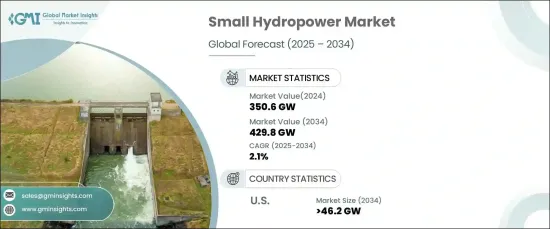 |
市場調查報告書
商品編碼
1666565
小型水力發電市場機會、成長動力、產業趨勢分析及 2025 - 2034 年預測Small Hydropower Market Opportunity, Growth Drivers, Industry Trend Analysis, and Forecast 2025 - 2034 |
||||||
預計到 2024 年全球小型水力發電市場容量將達到 350.6 吉瓦,預計 2025 年至 2034 年期間複合年成長率為 2.1%。

小型水力發電是指容量在 100 千瓦至 10 兆瓦之間的水力發電系統,是偏遠地區、小型公用事業和當地社區可採用的選擇。這些系統的可擴展性和多功能性使其成為全球轉向分散能源解決方案的關鍵貢獻者。這些系統支援離網和微電網設置,滿足缺乏可靠電網接入的地區的需求。技術改進,特別是渦輪機效率和成本的改進,進一步增強了全球採用小水力發電系統的可行性。
在美國,受聯邦政府減少溫室氣體排放和整合更多再生能源措施的推動,小水力發電市場預計到 2034 年將超過 46.2 吉瓦。激勵措施、稅收優惠和補助等優惠政策也正在鼓勵廣泛採用。這種更清潔的能源提供了實用可靠的解決方案,符合向更永續能源結構過渡的目標。
在亞太地區,小水力發電正成為解決偏遠和服務不足地區能源挑戰的重要手段。這些系統利用當地的水資源提供可靠的電力,最大限度地減少對化石燃料的依賴,同時提高能源安全。小型水力發電計畫能夠獨立於國家電網運行,這對偏遠社區尤其有利。透過促進自給自足和減少對環境的影響,小水力發電作為農村供電的有效解決方案繼續受到關注。
目錄
第 1 章:方法論與範圍
- 市場定義
- 基礎估算與計算
- 預測計算
- 資料來源
- 基本的
- 次要
- 有薪資的
- 民眾
第 2 章:執行摘要
第 3 章:產業洞察
- 產業生態系統分析
- 監管格局
- 產業衝擊力
- 成長動力
- 產業陷阱與挑戰
- 成長潛力分析
- 波特的分析
- 供應商的議價能力
- 買家的議價能力
- 新進入者的威脅
- 替代品的威脅
- PESTEL 分析
第4章:競爭格局
- 戰略儀表板
- 創新與永續發展格局
第5章:市場規模及預測:按地區,2021 – 2034 年
- 主要趨勢
- 北美洲
- 美國
- 加拿大
- 墨西哥
- 歐洲
- 英國
- 德國
- 法國
- 西班牙
- 義大利
- 俄羅斯
- 土耳其
- 挪威
- 亞太地區
- 中國
- 日本
- 印度
- 澳洲
- 世界其他地區
- 巴西
- 伊朗
第6章:公司簡介
- 24H - Hydro Power
- Agder Energi
- Andritz Hydro
- Derwent Hydroelectric Power
- Fortum
- General Electric
- Lanco Group
- RusHydro
- Siemens
- Statkraft
- Voith
The Global Small Hydropower Market is projected to achieve a capacity of 350.6 GW by 2024 and is expected to grow at a CAGR of 2.1% between 2025 and 2034. This growth is largely driven by rising demand for renewable energy, increased focus on sustainability, and advancements in technology.

Small hydropower refers to hydroelectric systems with a capacity between 100 kW and 10 MW, making them an accessible option for remote areas, small utilities, and local communities. Their scalability and versatility make these systems a key contributor to the global transition towards decentralized energy solutions. These systems support off-grid and microgrid setups, addressing the needs of regions lacking reliable grid access. Technological improvements, particularly in turbine efficiency and cost, further enhance the feasibility of adopting small hydropower systems globally.
In the United States, the small hydropower market is expected to surpass 46.2 GW by 2034, fueled by federal initiatives aimed at reducing greenhouse gas emissions and integrating more renewable energy sources. Favorable policies, such as incentives, tax benefits, and grants, are also encouraging widespread adoption. This cleaner energy source offers a practical and reliable solution, aligning with goals to transition to a more sustainable energy mix.
In the Asia Pacific, small hydropower is emerging as an essential tool to address energy challenges in remote and underserved regions. These systems leverage local water resources to deliver reliable power, minimizing reliance on fossil fuels while improving energy security. The ability of small hydropower projects to operate independently of national grids makes them particularly beneficial for isolated communities. By promoting self-sufficiency and reducing environmental impact, small hydropower continues to gain traction as an effective solution for powering rural areas.
Table of Contents
Chapter 1 Methodology & Scope
- 1.1 Market definitions
- 1.2 Base estimates & calculations
- 1.3 Forecast calculation
- 1.4 Data sources
- 1.4.1 Primary
- 1.4.2 Secondary
- 1.4.2.1 Paid
- 1.4.2.2 Public
Chapter 2 Executive Summary
- 2.1 Industry synopsis, 2021 – 2034
Chapter 3 Industry Insights
- 3.1 Industry ecosystem analysis
- 3.2 Regulatory landscape
- 3.3 Industry impact forces
- 3.3.1 Growth drivers
- 3.3.2 Industry pitfalls & challenges
- 3.4 Growth potential analysis
- 3.5 Porter's Analysis
- 3.5.1 Bargaining power of suppliers
- 3.5.2 Bargaining power of buyers
- 3.5.3 Threat of new entrants
- 3.5.4 Threat of substitutes
- 3.6 PESTEL Analysis
Chapter 4 Competitive landscape, 2024
- 4.1 Strategic dashboard
- 4.2 Innovation & sustainability landscape
Chapter 5 Market Size and Forecast, By Region, 2021 – 2034 (GW)
- 5.1 Key trends
- 5.2 North America
- 5.2.1 U.S.
- 5.2.2 Canada
- 5.2.3 Mexico
- 5.3 Europe
- 5.3.1 UK
- 5.3.2 Germany
- 5.3.3 France
- 5.3.4 Spain
- 5.3.5 Italy
- 5.3.6 Russia
- 5.3.7 Turkey
- 5.3.8 Norway
- 5.4 Asia Pacific
- 5.4.1 China
- 5.4.2 Japan
- 5.4.3 India
- 5.4.4 Australia
- 5.5 Rest of World
- 5.5.1 Brazil
- 5.5.2 Iran
Chapter 6 Company Profiles
- 6.1 24H - Hydro Power
- 6.2 Agder Energi
- 6.3 Andritz Hydro
- 6.4 Derwent Hydroelectric Power
- 6.5 Fortum
- 6.6 General Electric
- 6.7 Lanco Group
- 6.8 RusHydro
- 6.9 Siemens
- 6.10 Statkraft
- 6.11 Voith










